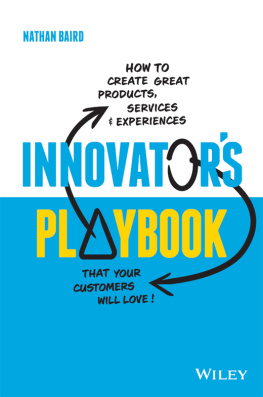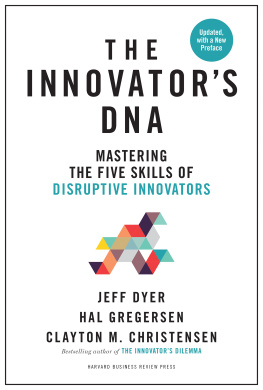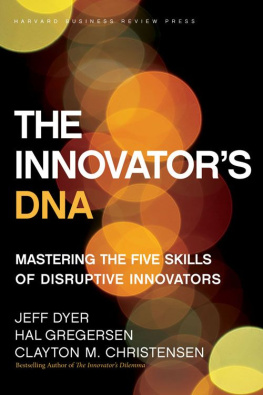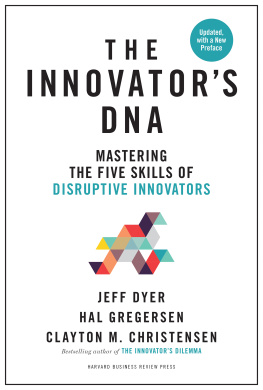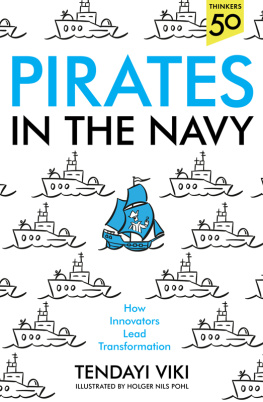Table of Contents
Driving Innovation from Within
Columbia University Press
Publishers Since 1893
New York Chichester, West Sussex
cup.columbia.edu
Copyright 2019 Kaihan Krippendorff
All rights reserved
E-ISBN 978-0-231-54836-6
Library of Congress Cataloging-in-Publication Data
Names: Krippendorf, Kaihan, author.
Title: Driving innovation from within: a guide for internal entrepreneurs / Kaihan Krippendorf.
Description: New York: Columbia University Press, [2019] | Includes bibliographical references and index.
Identifiers: LCCN 2019021922 (print) | LCCN 2019980593 (e-book) | ISBN 9780231189521 (hardback) | ISBN 9780231548366 (e-book)
Subjects: LCSH: Intellectual capitalManagement. | Creative ability in business. | New products. | Technological innovationsManagement. | Organizational change.
Classification: LCC HD53 .K74 2019 (print) | LCC HD53 (e-book) | DDC 658.4/063dc23
LC record available at https://lccn.loc.gov/2019021922
LC ebook record available at https://lccn.loc.gov/2019980593
A Columbia University Press E-book.
CUP would be pleased to hear about your reading experience with this e-book at .
Cover design: Noah Arlow
For Lucas, Kaira, and Makar.
May you do what you love.
Contents
by Rita Gunter McGrath
RITA GUNTHER McGRATH
OVERHEARD AT A recent conference: Today is the slowest day of your life. As the pace of change accelerates exponentially, established corporations are increasingly waking up to the reality that the rules have forever changed. Sustainable competitive advantages are growing shorter, less attainable, and more difficult to sustain. Meanwhile, growth by acquisition holds little value for investors, the old ways of organizing are dying off, and formal, structured innovation programs such as hackathons and incubators are often nothing more than innovation theater, doing very little to actually drive real business impact.
What, then, is the answer?
Kaihan Krippendorffs key insight is that the successful companies of tomorrow are finding a new way to compete by empowering the true drivers of innovative growth: their employees. These companies are implementing an entrepreneurial mind-set and creating organizational platforms that free employees to identify and seize innovative opportunities themselvesthereby merging the advantages of scale with the agility of a startup. While this was once deemed a nearly impossible task, tech giants born from lean approachesthe likes of Google, Alibaba, and Netflixare undeniable proof that this is not only attainable but absolutely vital.
In Driving Innovation from Within, Krippendorff offers a simple guide for how large corporations can move at the speed of startups by activating internal innovators. Drawing on five years of in-depth research and more than 150 interviews with employee innovators and the worlds top experts, he unites several of todays most important strategic conceptscorporate entrepreneurship, lean startup methodology, human-centered design, entrepreneurial intention, agile team-based structures, and self-coordinating organizationsinto a single applicable framework for leading an organization of employee entrepreneurs.
The IN-OVATE framework that Krippendorff introduces in this book compiles a set of proven tools and practices into an accessible structure that readers will be able to apply immediately within their own organizations to build a pipeline of competitive advantages. This framework identifies seven of the most common barriers to innovation and outlines the contours of a new type of organization that successfully unlocks the value of employees ideas.
Intent: Turn your employees into intrapreneurs.
Need: Communicate simple statements of purpose that describe what the market needs.
Options: Generate disruptive business ideas in hallways, not boardrooms.
Value blockers: Predict and neutralize business-model conflict.
Act: Adopt an actlearnbuild approach (rather than proveplanexecute).
Team: Assemble agile teams instead of siloed, hierarchical structures.
Environment: Shift to open platforms that allow employees to rally resources.
While there are plenty of books available offering senior leaders a top-down view on the challenge of innovative growth, Krippendorff writes instead for the employee, arming readers with a set of practical tools to more effectively drive innovation within an established organization. After reading this book, employees will be able to better understand their organizations strategy so that they can focus their efforts on fertile ground and learn what hinders their passionate pursuit of innovation so that they can build the game-changing ideas their organizations need to survive. Leaders, in turn, will walk away with a broader understanding of key organizational factorsincluding culture, structure, and talentthat block internal entrepreneurial activity so that they can move beyond innovation theater and focus on what really works.
As a seasoned strategy consultant and one of the worlds premiere transformation experts, Krippendorff is an authoritative guide to navigating organizations through this era of transient advantage. While we still do not have an absolute, proven system for innovative growth, this book provides one of the most comprehensive paths Ive seen, uniquely combining the breakthrough ideas of Steve Blank, George Day, Steve Denning, John Hagel, Alex Osterwalder, myself, and other leading thinkers into a single framework that can be easily activated within any organization. Through the IN-OVATE framework, readers will learn how to shift their organizational mind-set, break free from traditional thinking, and challenge the outdated status quo in order to embrace transformative possibilities, deploy disruptive ideas, and deliver bottom-line results.
The organization of tomorrow will gain a sustained competitive advantage by asking its employees to paint outside the lines. Let Kaihan show you how to create a masterpiece.
I THOUGHT I knew everything.
For more than fifteen years, the entire focus of my professional life had been on the dynamics of strategy and innovation. I had conducted some one thousand workshops and seminars across a wide spectrum of organizations and industries, helping managers generate creative business ideas to drive growth. Almost always, those workshops produced terrific ideas that left participants feeling enthusiastic and eager to proceed.
But their organizations rarely acted on these ideas.
I concluded, reluctantly, that getting an innovative idea through the bureaucracy of an established company was hard work and carried a low success rate. It seemed that large organizations, even when well intentioned, simply set up resource-allocation structures that tend to kill off radical ideas. An intractable dead end.



